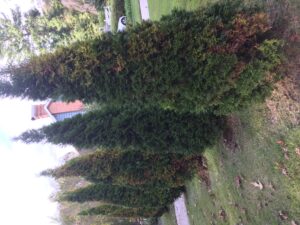Plant Health Alert – Arborvitae Problems
go.ncsu.edu/readext?830673
en Español / em Português
El inglés es el idioma de control de esta página. En la medida en que haya algún conflicto entre la traducción al inglés y la traducción, el inglés prevalece.
Al hacer clic en el enlace de traducción se activa un servicio de traducción gratuito para convertir la página al español. Al igual que con cualquier traducción por Internet, la conversión no es sensible al contexto y puede que no traduzca el texto en su significado original. NC State Extension no garantiza la exactitud del texto traducido. Por favor, tenga en cuenta que algunas aplicaciones y/o servicios pueden no funcionar como se espera cuando se traducen.
Português
Inglês é o idioma de controle desta página. Na medida que haja algum conflito entre o texto original em Inglês e a tradução, o Inglês prevalece.
Ao clicar no link de tradução, um serviço gratuito de tradução será ativado para converter a página para o Português. Como em qualquer tradução pela internet, a conversão não é sensivel ao contexto e pode não ocorrer a tradução para o significado orginal. O serviço de Extensão da Carolina do Norte (NC State Extension) não garante a exatidão do texto traduzido. Por favor, observe que algumas funções ou serviços podem não funcionar como esperado após a tradução.
English
English is the controlling language of this page. To the extent there is any conflict between the English text and the translation, English controls.
Clicking on the translation link activates a free translation service to convert the page to Spanish. As with any Internet translation, the conversion is not context-sensitive and may not translate the text to its original meaning. NC State Extension does not guarantee the accuracy of the translated text. Please note that some applications and/or services may not function as expected when translated.
Collapse ▲Arborvitae trees are quickly becoming the most popular tree in the nursery industry. Displacing the ‘Leyland Cypress’ as a favorite screening plant, the arborvitae blocks unwanted views. The plant is mostly pest free but as we have seen with so many other plants that we thought were ‘pest free’, once we plant too many of these or plant them improperly, diseases and insects can move in and cause problems.

‘Emerald’ arborvitae that are in shade are susceptible to stem diseases during wet years. In this case mowers had blown grass clippings under these plants holding moisture on the bark even longer which led to canker disease.
The two most common cultivars are ‘Green Giant’ and ‘Emerald’. ‘Green Giant’ is a large, needle bearing evergreen coniferous tree which is a hybrid cultivar of Thuja plicata and Thuja standishii the Western and Japanese arborvitae. It is a densely branched pyramidal habit reaching a mature height of 60 feet and width 20 feet.
‘Emerald’ is an American Arborvitae (Thuja occidentalis). ‘Emerald’ is an upright narrow plant that typically reaches a height of 20′ and width of 6′. There are many other species of arborvitae including some from Asia. T. occidentalis cultivars
In the main, here in western NC, we grow and use ‘Green Giant’ and ‘Emerald’. We have been seeing more problems with these trees. Spider mites can be a problem especially for trees located in areas of high heat such as the southwest facing sides of structures. Other arthropods that we can see are scale insects.
Diseases such as bot canker have started to infect trees that stay wet for too long, especially those in shade. Trees in shade will take longer to dry after a rain. Both ‘Green Giant’ and ‘Emerald’ are dense plants that stay wet after rains. Wet bark on branches eventually cracks and allows fungal infections to start.
A natural phenomena in all conifers is dropping older leaves. Each year conifers drop older leaves from the interior of the canopy. This will manifest as a general browning of the interior of the plant. This situation is not a disease. What can happen however is that the dropping leaves can build up in the interior of the plant holding moisture against the stems and trunk leading to disease. It is recommended to clear the interior of the trees of these fallen needles at least annually.







